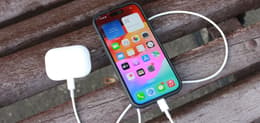To Pro or not Pro? Choosing the right iPhone 15
Updated on 24 May 2024
24 May 2024
9 mins read
Haziq
Published on 24 April, 2024 - Thinking about buying one of the newly released iPhone 15 models, but unsure which to choose? We’ll help you find out which is the right one for you.
What to know about the iPhone 15 models
When did the iPhone 15 come out?
In September 2023, Apple introduced the iPhone 15, barely a year after the previous generation of iPhone (iPhone 14 series).
What are the four iPhone 15 models?
Like its predecessor, the iPhone 15 comes in four different models. And, continuing the naming tradition begun with the iPhone 14, these four models are:
iPhone 15
iPhone 15 Plus
iPhone 15 Pro
iPhone 15 Pro Max
This overview will take a closer look at all of these smartphone models to give you a summary of the most important information about the iPhone 15 series.
Specifications
iPhone 15 | iPhone 15 Plus | iPhone 15 Pro | iPhone 15 Pro Max | |
|---|---|---|---|---|
Display | 6.1-inch Super Retina XDR Display | 6.7-inch Super Retina XDR Display | 6.1-inch Super Retina XDR Display | 6.7-inch Super Retina XDR Display |
Resolution | 2556 x 1179 (460 ppi) | 2796 x 1290 (460 ppi) | 2556 x 1179 (460 ppi) | 2796 x 1290 (460 ppi) |
RAM | 6 GB | 6 GB | 8 GB | 8 GB |
Capacity | 128/256/512 GB | 128/256/512 GB | 128/256/512 GB/1 TB | 256/512 GB/1 TB |
CPU | A16 Bionic | A16 Bionic | A17 Pro | A17 Pro |
Camera | Dual 48MP/12MP camera | Dual 48MP/12MP camera | Triple 48MP/12MP/12MP camera | Triple 48MP/12MP/12MP camera |
Aperture | Main: ƒ/1.6 Ultra wide angle: ƒ/2.4 | Main: ƒ/1.6 Ultra wide angle: ƒ/2.4 | Main: ƒ/1.78 Ultra wide angle: ƒ/2.2 Telephoto: ƒ/2.0 | Main: ƒ/1.78 Ultra wide angle: ƒ/2.2 Telephoto: ƒ/2.0 |
Body | Aluminium with colour-infused glass back | Aluminium with colour-infused glass back | Titanium with matte glass back | Titanium with matte glass back |
Colours | Black, Pink, Yellow, Green, Blue | Black, Pink, Yellow, Green, Blue | Black Titanium, White Titanium, Blue Titanium, Natural Titanium | Black Titanium, White Titanium, Blue Titanium, Natural Titanium |
What’s new in the iPhone 15?
One of the biggest things you might be wondering about the new iPhone 15 is how it differs from its predecessor, the iPhone 14. What innovations has Apple packed into the latest generation of their beloved smartphone? Is it worth upgrading now?
Design
Little has changed in the design between last year and this year. Both the iPhone 14 and the iPhone 15 feature a 6.1-inch screen, an aluminium body with glass back, and rounded corners.
The only significant alteration is that the iPhone 15 Pro and Pro Max now feature titanium frames rather than aluminium ones. This makes them somewhat heavier than the aluminium-framed iPhone 14 Pro and Pro Max, though they are by no means cumbersome. The titanium is likely harder and more resistant to scratches and dents than the aluminium as well, though this does depend on the alloy used.
Cables and Connectivity
Thanks in part to new EU requirements for standardized charging cables, the iPhone 15 series no longer uses Apple’s proprietary Lightning cables and jacks. Instead, they use the more universal USB-C cables, and are also USB 2-compatible. (The iPhone 15 Pro and Pro Max are USB 3-compatible.) This change signals a move toward greater consumer protection and improved sustainability (as consumers will not need to purchase special new cables for each device), though it may slightly inconvenience users who are already invested in Apple’s ecosystem and have Lightning-based peripherals.
It also means faster charging and data transfer on the Pro and Pro Max models, as USB 3 is faster than Lightning.

Processor
While the iPhone 14 series used the A15 Bionic and A16 Bionic chipsets, the iPhone 15 series features the A16 Bionic (for the 15 and 15 Plus) and the A17 Pro (for the Pro and Pro Max) chips.
What this means in simple terms is faster phones and better graphics. The A16 has a somewhat faster processing speed than the A15, and likewise, the A17 has a somewhat faster processing speed than the A16. Similar with graphics and memory. And while the improvements here aren’t huge (for example, an increase from 3.23 GHz to 3.46 GHz going from A15 to A16), they’ll add up enough to be felt. Also, the iPhone 15 is the first iPhone series in a number of years to see an increase in memory capacity.
Camera
The iPhone 15 series–part of it, at least–has also gotten a bit of a camera upgrade! We’ll take a close look at that next.
iPhone 15 camera: A highlight
Since the 11th generation of Apple’s iconic device, the iPhone has consistently had a dual 12 MP camera, with the Pro versions featuring a triple camera with an extra telephoto lens. Starting with the iPhone 14, the Pro models had a 48 MP triple camera. This meant that the iconic smartphone lagged behind its competitors in resolution, insofar as the Oppo 7 featured the first 50 MP camera on a smartphone in 2014, and Samsung, Xiaomi, and other brands have had such cameras on a few of their phones for several years.
And while megapixel resolution isn’t as important nowadays as other factors like lens quality, sensor size, and image processor effectiveness, this has still meant that printing larger versions of your amazing iPhone photos hasn’t been as rewarding as it could have been.
Now, however, with Apple’s latest series, all iPhone 15 models have 48 MP capacity. The 15 and 15 Plus still use a dual camera system, and the Pro models use a triple camera system. Optical zoom for the 15 and 15 Plus is 0.5x/1x/2x, and for the Pro and Pro Max, it is 0.5x/1x/2x/5x.
These camera systems are supported by a 1/1.7” sensor and Apple’s “Photonic Engine” technology, which combines the iPhone 15’s internal hardware with machine learning tools and image processing software to produce the beautiful photos (even in low light) so many have come to expect from Apple’s line of phones. This is, however, not an upgrade, as the same setup was available in the iPhone 14 series. The only difference is that the system now has access to a higher resolution camera on all iPhone 15 models.

iPhone 15
The entry-level iPhone 15 is built on the same aluminum frame and protected by the same Ceramic Shield glass as its predecessor. Apple claims that its Ceramic Shield glass (made by Corning) is stronger than the Corning Gorilla Glass used in competitors’ phones. However, independent drop tests don’t seem to back this up in any significant way–a fall is still a fall, and beyond a certain height, any smartphone is at risk. And given the price tag on high-end iPhones, you should really be protecting your technological investment as much as possible.
The good news, as mentioned above, is that even the “basic” model in the iPhone 15 series features a 48 MP main camera, which means you don’t need to spring for the more expensive iPhone 15 Pro or Pro Max to take really detailed photos.
And at 128 GB minimum storage space and 6 GB of RAM, the least expensive version still has plenty of space for apps, photos, videos, and music.
iPhone 15 Plus
The iPhone 15 Plus is an enlarged version of the basic model. (Think Ant-Man when he becomes Giant Man–except not quite so gigantic.) Its 6.7-inch screen diagonal provides excellent screen real estate for watching videos and playing games. Otherwise, it shares all the same features as its smaller sibling, the iPhone 15.
iPhone 15 Pro
The iPhone 15 Pro is an upgraded iPhone 15. What makes it “Pro”? Apple’s marketing department. All jokes aside, though, the Pro has several improvements over the base model. For one, it’s frame is titanium rather than aluminium, which means it is a little heavier, has a different range of colours, and may be more resistant to scratches and denting (though this might only be an issue on the sides of the phone, where the frame is not protected by glass).
Additionally, the Pro has a triple camera rather than a dual camera. The third lens is a telephoto one that enhances the optical zoom on the device.
Finally, the iPhone 15 Pro features a more powerful, more efficient chipset (the A17 Pro) and can be purchased with up to 1 TB of internal storage and 8 GB of RAM. (The iPhone 15 can only have up to 512 GB, and runs on the A16 Bionic chip.)
iPhone 15 Pro Max
Like the 15 Plus to the 15, the iPhone 15 Pro Max is a larger version of the iPhone 15 Pro. It, too, is built on a titanium frame, has a 48 MP triple camera with dedicated telephoto lens, and runs on the A17 Pro chipset, 8 GB of RAM, and up to 1 TB of storage. Additionally, while you can purchase a 128 GB iPhone 15 Pro, the smallest amount of internal storage available for the Pro Max is 256 GB.
Our conclusion on the iPhone 15 series
The iPhone 15 once again offers a small improvement over its predecessors. However, apart from the camera, it contains no breath taking revolution, but like the generations before it, Apple’s iPhone 15 series consists of some of the highest-quality phones on the market. They are competing with the latest of the Samsung Galaxy series, as well as the Google Pixel, Sony Xperia, and others. The series has everything any smartphone user might ever need and more, from wireless charging to storage space to 5G connectivity and high-quality cameras.
However, as a high-end phone, it is very expensive, starting at A$1,499 for the smallest base model and going up to A$2,899 for the most capacious Pro Max. Price has long been the biggest point of criticism among iPhone fans, and this clearly isn’t changing anytime soon. Eventually, you will be able to get a refurbished iPhone 15 for significantly less on Back Market. But you’ll have to wait until the phone has been out for several months before any refurbished models become available.
We said however, the iPhone 15 does not bring any ground breaking innovations, so you could instead choose to go for a refurbished iPhone 14 or refurbished iPhone 13 instead, for a fraction of the price of this new model (prices always go down for the older models when a new one is announced).
All devices and iPhone generations are professionally cleaned by our experts in the lab and checked for defects. You also get a 1-year warranty (just as you’d have if you purchased a new smartphone), and you have 30 days to test the phone to see if it really suits your needs. So you can choose a refurbished iPhone with peace of mind.

